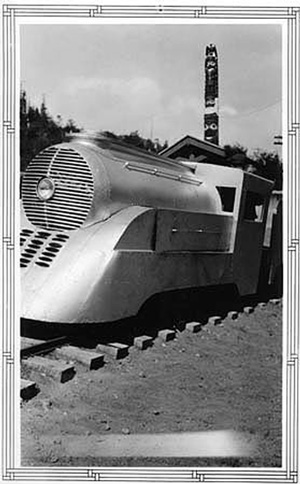
THE FAIR AT CITY PARK AND THE LITTLE TRAINBy JUNE ALLEN
July 08, 2013
P.J. (Pat) Gilmore was mayor that year and would be replaced in 1936 by J.A. (Jack) Talbot. Both were civic boosters at a time when boosters were sorely needed. No one person took credit in print - maybe it was the Chamber of Commerce - but in 1935 someone came up with the idea of holding an Industrial Fair, to be held at the town's new City Park. A Ketchikan Spruce Mills ad in the fair's booklet said, "Welcome to Ketchikan Industrial Fair. We are Prepared to Help in Ketchikan's Industrial Development by Furnishing Lumber for Building and Boxes for packing." The groundwork for industrial development was hopefully being laid - much as it is today! The old hatchery building that once straddled the creek in the hatchery/park had been moved across the street (we call it Fair Street now) and, remodeled. It would house the fair's exhibits, musical events, and other activities. The ball park was right there and so were the wide open spaces of the park and environs, and the fair was planned to be an exciting family event. It was! Invitations and notices went out to neighboring towns. At a dark time, Ketchikan found a way to lift the spirits of its populace! There were no farms, so there were no livestock exhibits, but there was a large mineral display that included gold bearing ore, silver bearing ore, copper bearing ore, and antimony and paladium or platinum ore. And there was another category for fine arts. The ladies had their exhibits, too, including those for sewing, knitting, crocheting, embroidery and everything from quilts to afghans, hand sewn gloves, beadwork and baby clothes - including a junior category. Then there was cooking and baking, best cakes, best pies, and best bread as well as canning local meats, fruits and salmon, of course. Prizes were offered for winners, in amounts ranging from 50 cents to $2.00. Curiously, prizes in the same categories in today's "state" fairs at Haines, Palmer and Fairbanks are not all that much larger! The fair in 1935 must have been a smashing success. It looked as if every business in town bought an ad in the fair booklet. Another fair was launched the following years and it proved successful, too. Then in 1937 there apparently was so much community enthusiasm that two men decided to provide something special for the children of Ketchikan. The story from the Ketchikan Alaska Chronicle issue of August 21, 1937, states: Miniature Train to Circuit Park
Fred Rockhill has earned much of the credit for the idea for the train. He and S.H. "Pete" Petersen opened Petersen and Rockhill, a garage and automobile service station, at the corner of Mission and Main Streets in May of 1930. They leased the building from Scotty Nichols until 1943 when Petersen bought it. The store was also was an auto parts store and a dealer with Briggs & Stratton air-cooled motors. The little train ran each year until the final Fair was held in 1939. Hitler's troops were seizing European countries that year and war clouds hovered in the distance. Preparations were underway for possible U.S. involvement in the war. Things were happening, and rumors were whispered of Japanese spies in the region's canneries and enemy submarines off the coast of Alaska. And then on May 8, 1941, the Chronicle carried a sad story about the fate of the little fairground train. "Ketchikan lost its 'railroad system' at the fairgrounds last night when the city council accepted an offer of the Ketchikan Public Utilities to buy the rails for three cents a pound and the cedar ties at 12 cents a tie. The utilities will use the rail and track at Ketchikan Lake." KPU did not need or want the engine. As sad as it was to lose the railroad, just seven months later the United States would enter World War II, Ketchikan would be under blackout and air raid alert, and no one would think about fairs and fun for the duration. City Park was used as temporary camp sites for CCC and military units. The Fairs were a thing of the past. But, what do you suppose happened to that little modernistic locomotive? Was it stored somewhere? Or was it cut apart and used elsewhere. Are its rails still used by KPU at Ketchikan Lakes? And has anyone ever thought about starting up another series of Ketchikan Fairs, somewhere?
Note: This feature story was written for Betty Lee (Lien), Nancy Hanson Rosenbalm, Pat and Des Moore, Liv (Knutsen) Hauge, and the others so far away who, after reading the story about city park, mentioned the little train they remembered.
First published by SitNews: July 19, 2002 E-mail your news &
photos to editor@sitnews.us
|
|||
